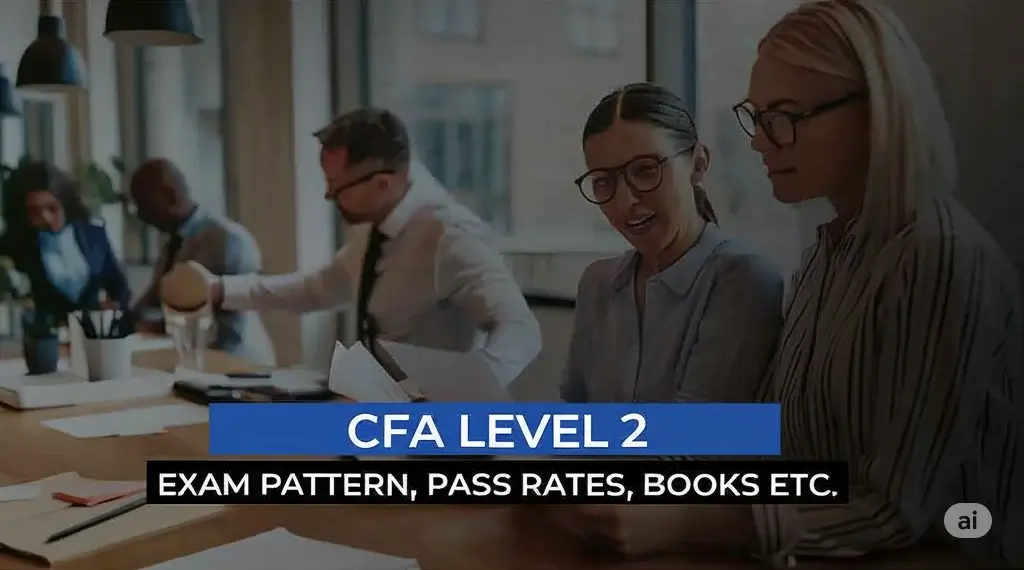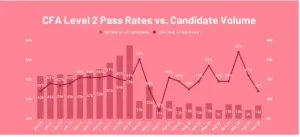CFA Level 2 – Exam Pattern, Pass Rates, Books etc.

Here's What We've Covered!
Building on the foundation of Level 1, CFA Level 2 expects you to delve further into investment concepts, valuation techniques, and financial modeling.
Where Level 1 is a matter of understanding principles, Level 2 is about applying them. The CFA Level 2 exam is ideal for those who have passed Level 1 and are ready for a more analytical journey. Expect in-depth case studies and advanced subject matter that require higher-order thinking.
Also Read- CFA Course Fees: Level 1, 2 and 3
CFA Level 2 Exam Pattern
Format & Duration
CFA Level 2 is now computer-based, offering multiple exam windows throughout the year. The exam has 22 item sets, also called vignettes, with 88 multiple-choice questions.
The Level 2 exam will consist of 60 questions to be answered in 4 hours and 24 minutes in two equal sessions of 2 hours and 12 minutes with an optional break between them.
Question Types (Item Sets & Vignettes)
The item sets you will see on the CFA Level II exam are standardized and there are 11 in each session, therefore, a total of 22 on the exam. Twenty of these items are scored, while two are in a trial phase and are not scored.
Each item set contains multiple-choice questions that must be answered using the information contained in the vignette. This is unlike the CFA Level I exam where the items are free-standing. You’ll have to consult the vignette before each item.
CFA® Program curriculum topic areas for Level II are randomly assigned on the exam. Both sessions may cover the same topics or other topics as well. Each item set vignette will be preceded by the topic and total point value. For example:
Sample 1: Ethical and Professional Standards
Scenario: Edgar Somer, CFA, is a newly hired portfolio manager at Karibe Investment Management. He previously worked at a rival firm where he achieved an average annual return of 11% using a small-cap value strategy. Upon joining Karibe, Somer is asked to approve marketing materials showcasing the following performance claims:
- A statement indicating “Somer has generated average annual returns of 11%.”
- A three-year performance record for Karibe’s composite accounts using a similar small-cap value strategy.
- A disclosure that assumptions and calculations underlying the returns are available on Karibe’s website.
Somer is also active on social media. He posts a link to a news story about an athlete penalized for unreported investment gains. Along with the link, Somer comments, “A client of mine had similar gains, but because I kept proper records, they avoided penalties. #HireAProfessional.”
The post leads readers to mistakenly believe the athlete is Somer’s client. Somer does not clarify.
Question: To comply with CFA Standards of Professional Conduct regarding performance presentation, what modification should Somer make?
- A: Revise the text about his investment returns.
- B: Modify the performance presentation of Karibe’s composite accounts.
- C: Adjust the content of the disclosure statement on assumptions.
Answer: A. The statement regarding Somer’s returns needs to indicate they were achieved at his previous firm to comply with the CFA Standards.
Sample 2: Financial Statement Analysis
EXAMPLE: Paris Rousseau, a wealth manager, counsels a client about adding to a real estate investments position by looking to add to an equity REIT. It analyzes fund data for three REITs to arrive at adjusted funds from operations (AFFO) and net asset value per share (NAVPS). The client also holds gold futures contracts that are nearing expiration. Rousseau notes that the futures market for gold is in contango and suggests rolling the position forward while maintaining the same dollar exposure.
Question: How does contango in the gold futures market affect the number of contracts required to maintain the same dollar exposure?
- A: The number of contracts will decrease.
- B: The number of contracts will stay the same.
- C: The number of contracts will increase.
Answer: A. In contango, the higher price of far contracts means fewer contracts are needed to maintain the same dollar exposure.
Exam Day Logistics
- ID Required: Valid passport, for verification Check-In Process: Arrive early for the mandatory check-in process.
- Check-In Procedure: Arrive early to complete the mandatory check-in process.
- Test Centre Protocols: Follow the instructions provided by the proctors, and ensure compliance with security checks. Approved calculators like the Texas Instruments BA II Plus are allowed.
Curriculum & Topic Weights
| Topics | Weight Range |
| Financial Statement Analysis | 10–15% |
| Fixed Income | 10–15% |
| Equity Valuation | 10–15% |
| Portfolio Management | 10–15% |
| Ethical and Professional Standards | 10–15% |
| Quantitative Methods | 5–10% |
| Economics | 5–10% |
| Derivatives | 5–10% |
| Alternative Investments | 5–10% |
| Corporate Issuers | 5–10% |
Recent Updates: The CFA Institute frequently updates the syllabus to reflect current trends in the financial industry. Candidates should review the latest curriculum to ensure they are prepared for any new material.
Also Read- Essential Insights into the CFA Level 2 Syllabus & Course Outline
Pass Rates
CFA Level 2 Pass Rates
May 2024 CFA Level II exam pass rate: 59%
August 2024 CFA Level II exam pass rate: 47%
November 2024 Level II exam pass rate: 39%
Why Pass Rates Matter
Understanding pass rates can help understand how challenging the exam is as well as how much preparation is usually needed. A passing rate shows the percentage of individuals who take it have a solid understanding of high-level finance principles. You must understand these numbers as a friendly reminder to respect this exam and go into it with a plan of attack! Pass rates assist candidates in gauging the difficulty of the exam and the amount of preparation they should be undertaking. A steady pass rate means that passing the exam relies on concentrated study and clear comprehension of the syllabus.
Strategies to Boost Success
- Practice many mock exams and simulate the exam conditions.
- Review weak areas regularly.
- This is much more about understanding vignettes and using concepts as opposed to memorizing.
Also Read- Unlock Job Opportunities After CFA Level 2
Recommended Books & Study Materials
Official bodies of CFA Institute Curriculum
The complete coverage of all topics is offered in the official curriculum. Benefits include:
- Detailed explanations.
- Questions for practice at the end of each chapter
- Streamlined material to match the exam
You may find the official curriculum here.
Third-Party Providers
Popular options include:
Kaplan Schweser: Provider of summarized notes, question banks, and video lessons.Visit Kaplan Schweser
Wiley Efficient Learning: Offers interactive study material and comprehensive study guides. Explore Wiley Resources.
Mark Meldrum: Video lectures and in-depth explanations. Check Mark Meldrum’s Courses
Budget-Friendly Video Material and Study Notes: IFT (Irfanullah Financial Training) Learn More at IFT
Choosing the Right Resources
Choosing the appropriate study resources is one of the pivotal phases of your CFA Level 2 preparation. Keep these factors in mind to ensure your resources fit your needs:
Learning Style
Visual learners: If you retain information better visually, try video lectures or infographics. Two providers that I think offer great video-based learning for the CFA are Kaplan Schweser and Mark Meldrum.
Text Learners: For reading, short study notes or end-of-chapter summaries may be what you need most.
Interactive Learners: If you learn by implementing stuff, go for the resources that offer mock tests and interactive question banks.
Budget
Study materials vary in cost. Although the CFA Institute’s official curriculum is covered in the registration fee, additional costs will be incurred when using third-party providers (e.g., Kaplan Schweser or Wiley).
If your budget is limited, think about free or lower-cost resources, such as social media platforms or free videos.
Balance cost against benefit — spending on good materials will pay off time-wise and increase the chances of your passing.
Time Availability
Align your resources with the time you have for prep.
If you are short on time, emphasize shorter notes or summary videos that quickly go over key concepts.
Depth materials like the official CFA curriculum are recommended for candidates with more time to prepare.
Reputation & Recommendations
Seek out success-proven methods and resources. Other candidates’ reviews and testimonials can help point you in the right direction.
Remember that your CFA Level 2 preparation should include specialized resources that prepare you for the higher difficulty level of the exam.
Additional Features
Some include personalized study plans, performance analytics, or adaptive learning tools.
If you need extra help, the doubt-solving sessions or live sessions can also be useful.
Make sure your provider has mock exams, critical to any prep.
So, if you’re able to take these factors into account, you’ll be able to choose resources that suit your learning style, schedule, and budget, helping to ensure your success on the CFA Level 2 exam.
Also Read- 9 Key Differences: CFA Level 1 vs 2 That You Should Know
Preparation Tips & Study Strategy
Building a Study Plan
- Should Plan for a Minimum of 300-350 Hours of Study Time
- Break down the syllabus into smaller segments and set weekly objectives.
- Try to finish the syllabus at least a month before your exam date and devote this month entirely to revision.
Effective Techniques
- So one of the biggest things you need to do here is get familiar with vignettes.
- Attempts with Time Limits: Solve problems under time limits. Just as in the Mains where there is limited time.
- Focus on Advanced Measurements: The advanced calculations concerning themes like fixed income, derivatives, etc. are exhaustive.
Revision & Mock Exams
- Take at least 3-5 mock exams.
- Study performance and strengthen weak areas
- Learn the exam format using mock exams.
Balancing Work and Study
For working professionals:
- Spend time 2-3 hours a day or more during weekends.
- Listen to summaries of key topics or watch video lectures on your commute.
For students:
- Incorporate CFA preparation into your school schedule.
- Collaborate, and work with others when possible in study groups.
Common Mistakes to Avoid in CFA Level 2 Preparation
- Overlooking Ethics: Ethics is a matter of primary concern and acts as a zero point.
- Not taking Mock Exams: Mock exams are essential as they highlight our weak points and also increase confidence.
- Trusting Third-Party Notes for Everything: Use the official notes to guide your studies for things that are not necessarily covered by third-party resources.
- Avoiding Procrastination: Start early and don’t leave it until the last minute
Techniques to Stay Motivated
- Form or join a study group to keep each other accountable.
- Set achievable goals and celebrate your milestones with yourself.
- Participate in events or webinars through CFA chapters.
Also Read- CFA Self Study Vs Coaching | What’s Best For You? 10 Factors You Need To Consider Before Choosing
Next Steps After Passing CFA Level 2
Transition to CFA Level 3
CFA Level 3 deals with portfolio management and wealth planning. Prepare in advance and learn how the essay-based format works.
Career Impact
Those who pass Level 2 have access to include:
- Investment Analyst
- Financial Advisor
- Portfolio Manager
Networking & Professional Development
- Join local CFA societies.
- Attend networking events.
- Use LinkedIn to network with industry people.
Also Read- CFA Level 2 Cleared? Top Job Opportunities Awaiting
IMS Proschool CFA Course
Program Overview
For CFA Level 2 possible outcomes, IMS Proschool gives customized preparation. Features include:
Modes of Learning: Online/Virtual.
Study Aids: Detailed notes, videos, and practice exams.
Support from Faculty: Learn from seasoned mentors with years of experience in the finance industry.
Why Choose IMS Proschool?
10+ Case studies and 1000+ questions.
Candidates reporting high pass rates.
For professional working schedules.
Individualized mentorship.
Career development support.
Placement support with resume building & Mock interviews.
Access 100+ curated jobs on the placement portal.
For more information, check out the IMS Proschool CFA Course.
Conclusion
CFA Level 2 is not without its challenges but is well worth the effort. These tips will guide you on your journey to success if you work hard with the right resources. So get started early, stay disciplined, and capitalize on every chance you have to practice. Consider enrolled courses, like IMS Proschool, to help you clarify your preparation.
FAQs
How is CFA Level 2 different from Level 1?
Analysis: Explicitly named learning and its articulation are Level 1 whereas analyzing and evaluating are Level 2.
Format of questions: In level 1, MCQ questions will be asked to test knowledge of the key terms, concepts, and formulas. Level 2 is a multiple-choice, vignette-based exam that measures how candidates develop solutions to issues.
Genre: Level 1 covers a lot of ground and Level 2 delves deeper into investment analysis.
Memorization: Level 1 requires recall of the formula/definition, and Level 2 de-emphasizes memorization.
Ultimately, as per the guidelines provided: The difficulty level of question 2 (Advanced, higher than level 1 questions)
Time pressure: Level 1 candidates get 1.5 minutes per question, Level 2 candidates get 3 minutes per question
Depth of Content: Level 2 covers the same topics as Level 1 but at greater depth.
What’s the recommended study time for CFA Level 2?
CFA Level 2 exam — Recommended time would be around 350 hours over six to nine months This translates into an average of roughly one hour and 20 minutes of studying each day.
How to plan your study time
- Customize your schedule
- Educate yourself on longer days, with a break from others.
- Study as early as you can to factor in some buffer time if you require it.
- Make sure to read all the topic areas, which are specifically equity investments, fixed income, financial reporting, derivatives, quantitative methods, and corporate finance.
- Study in the order that the curriculum sets out, or in an order that suits you best.
- Do not leave ethics until the end of the study.
Which is the most challenging topic in CFA Level 2?
The Most Difficult CFA Level 2 Topics are normally Financial Statement Analysis, Portfolio Management, and Ethics and Derivatives.
When is the right time to register for Level 2?
When to register for the CFA Level 2 exam may depend on the exam period. Registration deadlines depend on the exam date window.
Eligibility Details for 2025 CFA Exam: Level 2.
- Must have a bachelor’s degree or be in the final year of the bachelor’s program.
- Must have 4,000 hours or over a minimum of 3 years of relevant professional experience.
| Exam Cycle | Registration Opens | Early Registration Deadline | Standard Registration Deadline | Exam Window |
| February 2025 | 9 May 2024 (Window closed) | 9 Jul 2024 | 7 Nov 2024 | 13-16 Feb 2025 |
| May 2025 | 8 Aug 2024 | 16 Oct 2024 | 6 Feb 2025 | 21-25 May 2025 |
| August 2025 | 6 Nov 2024 | 29 Jan 2025 | 6 May 2025 | 27-31 Aug 2025 |
| November 2025 | 12 Feb 2025 | 9 Apr 2025 | 5 Aug 2025 | 19-23 Nov 2025 |
Note: Always check the official CFA Institute website for the most up-to-date fee and exam schedule information.
Do I need special preparation for vignette-style questions?
Yes, practice reading and interpreting vignettes to answer related questions effectively. Each vignette typically has between 4 and 6 questions. This means that you will have to spend 12-18 minutes on each vignette (while reading is included in this as well) and you will need to keep dividing around 3 minutes for each vignette question. Each multiple-choice question has 3 answer options.
Resent Post
>
Emerging commerce career options in India (2026): From CA to Data Analyst
>
ACCA Opportunities You Didn’t Know About – Think Beyond Audit!
>
Which Courses After 12th Commerce With High Salary Are in Demand Worldwide?
>
How to Find ACCA Jobs Online After Qualifying: Real Portals, Tips & Career Guidance
>
Financial Modelling Classes in Hyderabad: Your Guide to the Best Institutes
Follow Us For All Updates!




